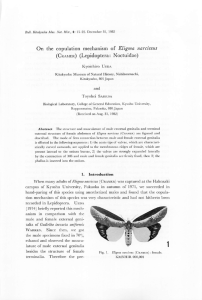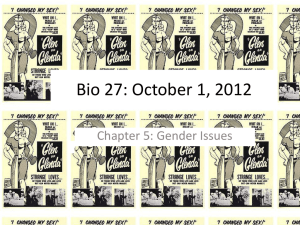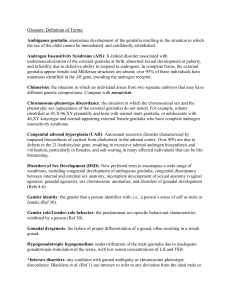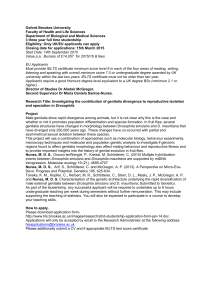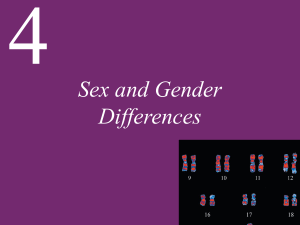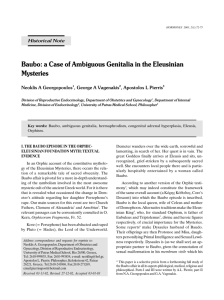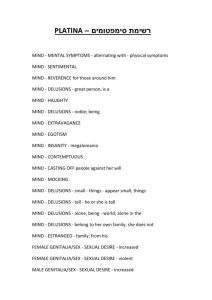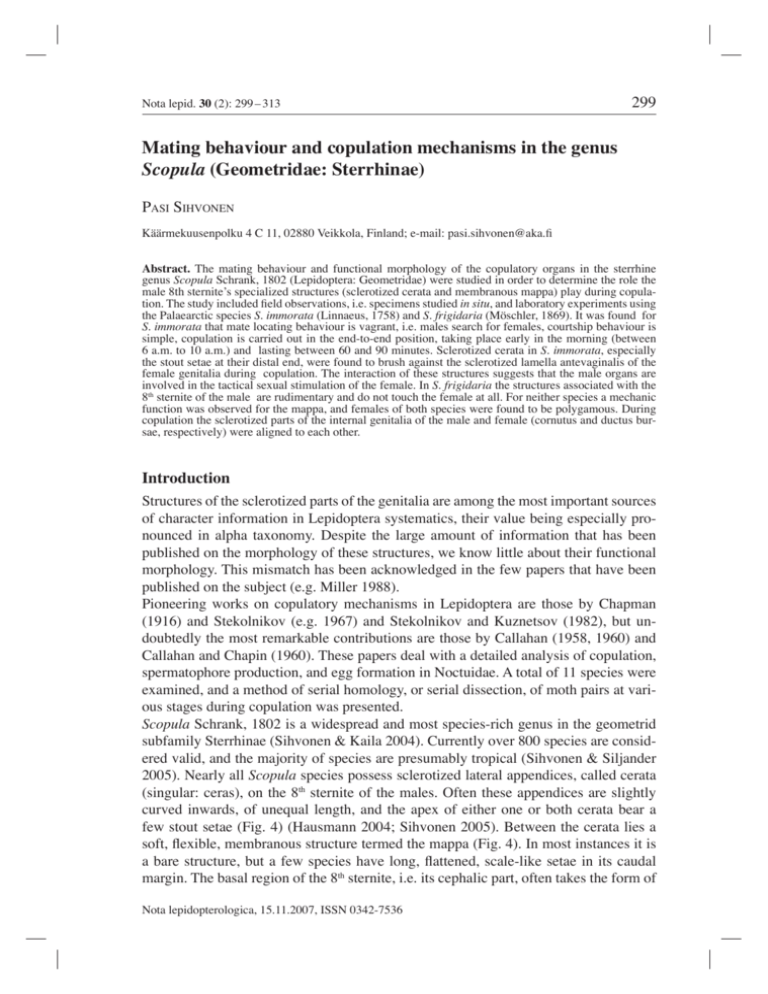
Nota lepid. 30 (2): 299 – 313
299
Mating behaviour and copulation mechanisms in the genus
Scopula (Geometridae: Sterrhinae)
PASI SIHVONEN
Käärmekuusenpolku 4 C 11, 02880 Veikkola, Finland; e-mail: pasi.sihvonen@aka.fi
Abstract. The mating behaviour and functional morphology of the copulatory organs in the sterrhine
genus Scopula Schrank, 1802 (Lepidoptera: Geometridae) were studied in order to determine the role the
male 8th sternite’s specialized structures (sclerotized cerata and membranous mappa) play during copulation. The study included field observations, i.e. specimens studied in situ, and laboratory experiments using
the Palaearctic species S. immorata (Linnaeus, 1758) and S. frigidaria (Möschler, 1869). It was found for
S. immorata that mate locating behaviour is vagrant, i.e. males search for females, courtship behaviour is
simple, copulation is carried out in the end-to-end position, taking place early in the morning (between
6 a.m. to 10 a.m.) and lasting between 60 and 90 minutes. Sclerotized cerata in S. immorata, especially
the stout setae at their distal end, were found to brush against the sclerotized lamella antevaginalis of the
female genitalia during copulation. The interaction of these structures suggests that the male organs are
involved in the tactical sexual stimulation of the female. In S. frigidaria the structures associated with the
8th sternite of the male are rudimentary and do not touch the female at all. For neither species a mechanic
function was observed for the mappa, and females of both species were found to be polygamous. During
copulation the sclerotized parts of the internal genitalia of the male and female (cornutus and ductus bursae, respectively) were aligned to each other.
Introduction
Structures of the sclerotized parts of the genitalia are among the most important sources
of character information in Lepidoptera systematics, their value being especially pronounced in alpha taxonomy. Despite the large amount of information that has been
published on the morphology of these structures, we know little about their functional
morphology. This mismatch has been acknowledged in the few papers that have been
published on the subject (e.g. Miller 1988).
Pioneering works on copulatory mechanisms in Lepidoptera are those by Chapman
(1916) and Stekolnikov (e.g. 1967) and Stekolnikov and Kuznetsov (1982), but undoubtedly the most remarkable contributions are those by Callahan (1958, 1960) and
Callahan and Chapin (1960). These papers deal with a detailed analysis of copulation,
spermatophore production, and egg formation in Noctuidae. A total of 11 species were
examined, and a method of serial homology, or serial dissection, of moth pairs at various stages during copulation was presented.
Scopula Schrank, 1802 is a widespread and most species-rich genus in the geometrid
subfamily Sterrhinae (Sihvonen & Kaila 2004). Currently over 800 species are considered valid, and the majority of species are presumably tropical (Sihvonen & Siljander
2005). Nearly all Scopula species possess sclerotized lateral appendices, called cerata
(singular: ceras), on the 8th sternite of the males. Often these appendices are slightly
curved inwards, of unequal length, and the apex of either one or both cerata bear a
few stout setae (Fig. 4) (Hausmann 2004; Sihvonen 2005). Between the cerata lies a
soft, flexible, membranous structure termed the mappa (Fig. 4). In most instances it is
a bare structure, but a few species have long, flattened, scale-like setae in its caudal
margin. The basal region of the 8th sternite, i.e. its cephalic part, often takes the form of
Nota lepidopterologica, 15.11.2007, ISSN 0342-7536
300
SIHVONEN: Copulation in the genus Scopula
a sclerotized, convex, plate-like structure (Fig. 4). The cephalic margin of 8th sternite
may be medially elongated, medially invaginated or trifid in shape (Sihvonen 2005).
Similar structures are also found in closely related genera of Scopulini, for example
in Lipomelia Warren, 1893, Problepsis Lederer, 1853, and Somatina Guenée, 1858
(Sihvonen 2005).
These structures of the male 8th sternite are species-specific in shape, and their value as
a diagnostic tool in alpha-taxonomy is well recognized. As a result, they are routinely
illustrated in taxonomic works (e.g. Covell 1970; Hausmann 2004). Interestingly, in a
number of species the cerata are polymorphic, i.e. their length varies within a species,
and relative proportions of different length morphs vary geographically (Hausmann
1999; 2004). The function of these peculiar, specialised structures has remained unknown, but Hausmann (1999) assumed that the 8th sternite may play a mechanical role
during copulation, perhaps similar to that noted in the geometrid genus Eupithecia
Curtis, 1825 (Larentiinae) (Mikkola 1994). Indeed, in fresh specimens or specimens
that have been macerated with potassium hydroxide, the cerata of a number of species
can be moved laterally. This movement is allowed by a loose, membranous abdominal
cuticle at a point where the cerata join the base of the 8th sternite. In other words, the
abdominal skin flexes when the cerata are moved laterally (unpublished, personal observation).
The purpose of this study is to document the mating behaviour of S. immorata (Linnaeus,
1758), and in particular to investigate what function the above-mentioned specialized
pregenital structures may play during copulation. The latter aspect was studied with the
aid of two species, S. immorata (Linnaeus, 1758) and S. frigidaria (Möschler, 1869).
Material and Methods
The term ‘functional morphology’ has been used in the literature in various ways. I follow Naumann (1987) and use it to describe the interaction of male and female genitalia
structures during copulation, i.e. the mechanism of copulation. The terminology for
genitalia follows Covell (1970), Klots (1970) and Kristensen (2003).
Species studied and their genital structures
The two species were chosen for the study on the grounds that morphological structures
of their genitalia are quite different (Figs 1–9). It was hoped that inclusion of morphologically different species might help to better understand the copulation mechanisms
and the possible role of male’s 8th sternite structure and so to allow wider interpretation
of the results.
S. immorata. A Euro-Siberian species, which is widely distributed in temperate areas.
It is a thermophilous species preferring open habitats, including waste lands, meadows and road sides. The larva is polyphagous, feeding on withered leaves of herbaceous plants, for example on Plantago (Plantaginaceae), Taraxacum (Asteraceae) and
Hieracium (Asteraceae) (Ebert 2001; Hausmann 2004). The species is usually bivoltine
in June and August, except in the northern and mountainous areas of its distribution,
where the second generation is incomplete or absent.
301
Nota lepid. 30 (2): 299 – 313
socius
valvula
sacculus
sclerotized apex
cornutu
diverticulum
arm of juxta
1
2
papillae anales
posterior lobes
lamella
antevaginalis
8th tergite
3
ostium bursae
cerata
mappa
signum
base
spermatophore
4
5
Figs 1–5. Male and female genitalia of Scopula immorata. 1. Male genitalia and phallus in ventral view,
coremata removed (slide PS1040). 2. phallus, vesica everted (PS1041). 3. 8th abdominal tergite (PS1041).
4. 8th abdominal sternite (PS1041). 5. Female genitalia in ventral view (PS1043).
302
SIHVONEN: Copulation in the genus Scopula
M a l e g e n i t a l i a (Fig. 1). Ovoid, symmetrical; socii membranous, covered with
short setae; valvae consist of ventral sacculi, sclerotized and acute; and dorsal valvuli,
membranous, blunt ending, setose. The sacculi have a small membrane at their proximal part allowing lateral movement. Juxta with large lateral arms, widest apically; vinculum large, U-shaped; transtilla weakly developed, membranous bridge. Phallus (Figs
1, 2) wide, straight; apex bearing one large and several small sclerotized teeth dorsoventrally; caecum slightly curved ventrally; vesica opens ventrally, with one large,
blunt-ended diverticulum that opens to left (when viewed ventrally); cornutus large,
acute; ductus ejaculatorius opens ventrally. 8th tergite weakly developed (Fig. 3); cerata
of unequal length, apices covered with stout setae; mappa round; base partly concealed
by membrane (Fig. 4). The cerata of this species have not been recorded to be polymorphic (Hausmann 2004).
F e m a l e g e n i t a l i a (Fig. 5). Papillae anales soft, setose; apophyses posteriores and
a. anteriores long; lamella postvaginalis sclerotized, narrow ring; lamella antevaginalis
large, sclerotized, proximal membrane allows ventral movement; lamella antevaginalis
conceals ostium bursae; ductus bursae wide, short, partly sclerotized; ductus seminalis
ventrally from proximal part of ductus bursae; corpus bursae elongated sac; signum
small, weakly spinulate. Female abdominal segments weakly sclerotized, undifferentiated.
S. frigidaria. A Holarctic species, its distribution in the Palaearctic region being confined to its northernmost areas, whereas in the Nearctic region it is widespread from
Alaska to Newfoundland. It occurs in open tundra habitats, but is also found in coniferous and mixed forests. In the Palaearctic region the larva has been recorded to
feed on the leaves of Vaccinium myrtillus (Ericaceae), in the Nearctic region immature
stages are unrecorded (Covell 1970). The species is univoltine from early June to late
August.
M a l e g e n i t a l i a (Fig. 6). Ovoid, symmetrical; valvae short, resulting in fused appearance; socii long, narrow, covered with setae; sacculi melanized, short, acute; valvuli
short, membraneous, setose; juxta round, lateral arms short; vinculum large, U-shaped;
transtilla weakly develoed membranous bridge. Phallus (Figs 6, 7) long, narrow, caecum slightly curved ventrally; vesica simple sac, opening ventrally, without cornutus;
base of ductus ejaculatorius weakly sclerotized. 8th tergite weakly developed (Fig. 8),
cerata short, symmetrical; mappa round; base partly concealed by a membrane. The
cerata of this species have not been recorded to be polymorphic (Hausmann 2004).
F e m a l e g e n i t a l i a (Fig. 9). Papillae anales soft, setose; apophyses posteriores
and a. anteriores long; lamella postvaginalis reduced; lamella antevaginalis narrow,
horse-shoe shaped; ostium bursae small, sclerotized, cap-shaped lobe; ductus bursae
unsclerotized; ductus seminalis ventrally from proximal part of ductus bursae; corpus
bursae elongated sac; signum large, consisting of separate spinules or absent altogether.
Female abdominal segments weakly sclerotized, undifferentiated.
Copulation experiments
Field experiments using S. immorata, including observations and material acquisition,
were carried out at various sites in southern Finland between 2000–2005. Laboratory-
303
Nota lepid. 30 (2): 299 – 313
socius
papillae anales
arm of juxta
ostium
bursae
valvula
sacculus
lamella
antevaginalis
6
7
posterior lobes
mappa
signum
cerata
8th tergite
base
8
9
Figs 6–9. Male and female genitalia of Scopula frigidaria. 6. Male genitalia and phallus in ventral view,
coremata removed (PS1044). 7. Phallus, vesica everted (PS1058). 8. 8th abdominal segment (PS1058),
9. female genitalia (PS1047).
bred specimens were reared in plastic cages, about 25 × 25 × 15 cm in size. When moths
had emerged, the breeding cages were taken outdoors. The cages had small holes on
their sides and on top, allowing female pheromones to dispense. No field or laboratory
experiments of live specimens were carried out for S. frigidaria.
Entire mounts of copulating pairs were obtained from specimens caught in situ in the
field, and from specimens that were bred from ova and which copulated in breeding
cages. The specimens were anesthetized with chloroform and stored in a freezer. The
abdomens were carefully separated from the thorax with the aid of fine scissors and
macerated in a hot (7 mins at 92 ºC) potassium hydroxide (KOH) solution. The abdomens and genitalia were dissected in 5% aqueous ethanol. Scales were removed
from abdomens with help of fine brushes, the organs were stained with a weak solution of Chlorazol Black, and prepared following routine techniques (Hardwick 1950).
304
SIHVONEN: Copulation in the genus Scopula
The male vesica was everted via the caecum that was cut open by placing the phallus
inside a hypodermic syringe (Sihvonen 2001). The structures were preserved temporarily in glycerol, which allowed examination from various perspectives. They were
subsequently transferred into ethanol tubes for 24 hours for glycerine removal and then
mounted in Euparal. The cover glass was supported by small glass props. Structures
were prepared using a Wild MZ6 stereomicroscope (maximum magnification 64x).
Characters were examined using a Wild M10 (512x) and Leitz Diaplan phase contrast
compound microscope (1560x).
The number of matings was assessed by counting the number of spermatophores stored
in the female bursa copulatrix. The method relies on the assumption that only one spermatophore is transferred during each copulation (for criticisms, see Cordero 1999).
Results
Mating behaviour
Males of S. immorata were found to express female-searching behaviour early in the
morning, approximately from 6 to 10 a.m. This vagrant behaviour started soon, between one to five minutes, after sun had started to warm up the observation site. The
males flew rapidly, just above the low vegetation, in a zigzagging manner towards the
wind. Every now and then males landed in the vegetation, beat their wings swiftly a
few times, and continued flying after a while.
Most females emerged from the pupa in the evening or during the night. They remained
still and did not start to attract males until early in the morning, around 6 a.m. They
stayed hidden in the vegetation, head facing upwards, and held the tip of the abdomen
in an elevated position. After a male had located the female, they both remained with
their heads upwards for a few seconds (Fig. 10), whereupon the male tried to locate the
tip of the abdomen of the female, turning 180 degrees. To end up in this position, males
always turned from the left-hand side (Figs 11, 12). It was when in this end-to-end position that the male attached its genitalia to the female and copulation started (Fig. 12).
Copulation was observed to last 60 to 90 minutes (n = 9), and three phases were more
or less identifiable each time:
1) Male moving its genitalia and 8th sternite back and forth (up and down), rubbing
the cerata against the lamella antevaginalis of female. Cerata did not move laterally
(Fig. 12).
2) Male moving its abdomen from side to side in a snake-like manner including both
lateral and dorso-ventral moves (Fig. 12).
3). When viewed ventrally (as in Fig. 13), male turned slightly to ‘left’, thus male
and female were at an angle of about 160 degrees. Stages one and two lasted about
15 minutes each, stage three lasted from five to ten minutes, after which the male detached itself from the female. After copulation was over, the female remained still until
the following night, when oviposition took place. In three instances copulating pairs
305
Nota lepid. 30 (2): 299 – 313
10
11
12
13
Figs 10–13. Sequence of events occurring during copulation in Scopula immorata in ventral view. Pictures
were taken through transparent plastic. 10. Male approaches female by wing fanning, heads upwards
(length of this phase is about 10 seconds). 11. Male contacts and flexes abdomen toward female genitalia
and starts to turn to end-to-end position (approx. 10 seconds). Male always turned to end-to-end position
from left-hand side (when viewed ventrally). 12. Copulation, end-to-end position (60 to 90 minutes).
Male rubbed the cerata against the lamella antevaginalis of female, both back-and-forth and side-to-side
movements were observed. 13. End of copulation, male has tilted to left, abdomens are at an angle of 160
degrees (5–10 minutes).
remained attached to each other, in phase three (Fig. 12), until the following night. I
found two copulating pairs in the field in the afternoon that were apparently in phase
three of copulation. When disturbed, these separated from each other immediately and
the male took to the wing.
It was noted that males were more active in sunny weather, on cloudy mornings most
males were not eager to fly at all. Vagrant behaviour of males ended by 10 a.m. The
same behaviour pattern was observed in the laboratory-bred specimens, when breeding
cages were taken outdoors. Both males and females were active at dusk and during the
night, and both sexes are attracted to light. Despite an intensive search in the field, and
observations made in the laboratory, no mate searching behaviour was observed at dusk
306
SIHVONEN: Copulation in the genus Scopula
and during the night. Neither sex was observed to feed on nectar plants. Females were
observed to lay eggs from dusk until around midnight.
Field observations and laboratory experiments showed that in Scopula both sexes can
copulate several times. Up to two spermatophores were found inside the corpus bursae of both studied species. One male S. immorata was observed to copulate with two
different females under laboratory conditions. A further three males tried to copulate
for the second time with a different female, but the proper copulation posture was not
assumed.
Interaction of male and female genitalia structures during copulation
S. immorata. The membrane between the 8th abdominal segment and the genitalia is
loose and partly folded. Prior to copulation, the male everts its genitalia from this membrane pocket, so that the end of its abdomen projects in a telescopic manner. Before the
male inserted its phallus into the ostium bursae of the female, the valvae changed their
position remarkably. The sclerotized, ventral sacculi were curved about 90 degrees medially and came into contact with the region of the female genitalia between the ventral
margin of the ostium bursae and its ventral sclerotized ring. The membranous dorsal
valvuli were curved even more, about 180 degrees ventrally and opened the lamella
antevaginalis of the female genitalia, thus exposing the ostium bursae (Fig. 14). The
lateral arms of the juxta came into contact with the areas lateral of the ostium bursae,
apparently performing a support function. The socii were inserted into the membranous
region between papillae anales and ostium bursae (Fig. 14).
During copulation phases one and two (Fig. 12), when the male moved its body from
side to side and back and forth, it rubbed its cerata against the sclerotized lamella antevaginalis of the female (Fig. 14) (Note: The illustrated specimens were slightly distorted when they were placed under a cover slip for photography. As a result the male
cerata do not touch the lamella antevaginalis in the picture). No lateral or pincer-like
movements of the cerata were observed. At the same time the male inserted its phallus
into the ostium bursae and started to evert its vesica. Also, the mappa was found to be
adjacent to the lamella antevaginalis during copulation.
The vesica was everted into the cephalic part of the ductus bursae, beyond the branching point of the ductus seminalis (Fig. 15). The sclerotized teeth at the apex of the phallus and cornutus were found to rest in a position at the inner wall of the ductus bursae,
corresponding to the sclerotized parts on the inner wall of the ductus bursae of the
female genitalia (Fig 15, Table 1). This position was noted in all pairs examined. When
fully everted, the vesica blocks the entire ductus bursae but it does not reach the corpus
bursae. The spermatophore is formed in about 30 minutes and it is stored inside the
corpus bursae (Fig. 5). The spermatophore is a simple, unsclerotized sac, which loosely
fills the entire corpus bursae. The number of spermatophores found in the corpus bursae
varied from zero to two, with most specimens having one. The material examined did
not allow for conclusions to be made about the function of the signum.
S. frigidaria. As in S. immorata, the valvae of S. frigidaria changed their position
quite remarkably (Figs 17, 18). The ventral sacculi were curved by about 90 degrees
307
Nota lepid. 30 (2): 299 – 313
papillae anales
socius
tegumen
8th tergite
scerotized margin
of ostium bursae
base of phallus
vinculum
arm of juxta
base of valva
valvula
base of 8th sternite
lamella antevaginalis
ceras
Fig. 14. Lateral view of Scopula immorata in copula (unstained) (PS 1059). Female is on the left, male is
on the right. Valvula of male valvae have turned ventrally by about 180 degrees and mechanically push
open the lamella antevaginalis of female genitalia allowing phallus to penetrate into the ostium bursae.
Afterwards, sclerotized cerata rub against sclerotized lamella antevaginalis.
medially and came into contact with the cap-shaped sclerotizations of the ostium
bursae. The dorsal valvuli were curved even further, by about 180 degrees, and fit into
the horse-shoe shaped pocket of the lamella antevaginalis. The socii were inserted on
the sides of the papillae anales, the latter being pushed inwards towards the female
abdomen.
The proximal part of the ductus bursae has a dorsal, half-ringed weak sclerotization,
ventrally the ductus wall is membranous. The ductus bursae is concave in shape (when
viewed through a cross-section of the ductus bursae). When the male inserts its phallus
into the ductus bursae, the weakly sclerotized dorsal wall opens and the ductus bursae
assumes a round shape. The number of spermatophores found in the corpus bursae
varied from zero to two, with most specimens having one. Unlike in S. immorata, the
rudimentary cerata and large mappa of male 8th sternite were not observed to have any
mechanic function during copulation (Fig. 16).
Discussion
Mating behaviour. For a good number of Lepidoptera species, especially for those that
are nocturnal and small, we do not know the basic attributes of their biology. Among
those aspects are behavioural traits, and to give a concrete example, the timing of mating of the Small Tortoiseshell (Nymphalis urticae) was discovered only a few years
308
SIHVONEN: Copulation in the genus Scopula
ago, despite this being a common and familar species that occurs widely throughout
the Palaearctic region. Males of this species search for females in bright daylight, and
when a female is found, the pair fly into a sheltered place and the actual copulation
takes place around midnight (Mikkola et al. 2005). A similar lack of basic biological
information for S. immorata made it difficult to study the mechanisms of its copulation because it was unknown at what time of the day copulation takes place. Rearing
experiments revealed that mate location and copulation take place in the early morning
sunshine. This was against the a priori assumption that a nocturnal species is likely to
copulate during the dark hours of the day.
It is unknown what kind of mate locating behaviour is predominant in the large, cosmopolitan genus Scopula. The strategy where males search for passive females in the
morning sunshine, is here reported for S. immorata. In addition, I have made similar field observations for the Palaearctic S. ternata (Schrank, 1802) and S. floslactata
(Haworth, 1809) (unpublished). The vagrant strategy, combined with early morning
activity, may therefore be a common strategy at least for the North Palaearctic species
of the genus.
The courtship behaviour of S. immorata was found to be simple; after the male had
located the female, copulation occurred in a tail-to-tail position (the male remained facing in the opposite direction as the female). The tail-to-tail position is typical for most
Lepidoptera (for an overview, see Phelan & Baker 1990; for exceptions see Charlton &
Cardé 1990). It is likely, however, that more complex and interactive courtship behaviour prior to copulation is widespread in Scopula and related genera of Scopulini. The
reason for this is that unlike in S. immorata, which has vestigial hair pencils on its hind
legs, males of a number of other Scopulini species possess specialized, eversible scent
emitting structures in their hind tibiae, termed hair pencils (Hashimoto 1992, Sihvonen
2005). Some of these secondary sexual structures are very pronounced, e.g. in Scopula
urnaria (Guenée, 1858, illustrated in Sihvonen 2005). Further, a few species of closely
related genera possess eversible scent structures on the male 8th abdominal segment
(e.g. Pseudasellodes fenestraria (Guenée) or on the hind wings (e.g. Crypsityla quinquelineata (Dognin), illustrated in Sihvonen & Kaila 2004). Possibly, species whose
males either lack or have vestigial scent-emitting secondary sexual characters, such as
S. immorata, have a simple courtship behaviour whereas species with such structures
have a more complex and interactive courtship behaviour. In an extensive comparative
study that was carried out on phycitine moths (Pyralidae), it was found that all species displaying the interactive courtship pattern possessed male scent-disseminating
structures on the forewing and/or the eight abdominal segment, whereas those species
engaging in a simple courtship had neither of those structures or only vestiges of them
(Phelan & Baker 1990).
Functional morphology of the male and female genitalia. The specific function of
the male 8th sternite in Scopula and closely related genera during copulation is still
unclear. Mikkola (1994) suggested for certain species of North American Eupithecia,
which possess species-specific structures similar to cerata, that the recognition function between sexes during the early phase of copulation has shifted from the valvae to
309
Nota lepid. 30 (2): 299 – 313
1
1
2
3
3
4
6
5
2
4
5
6
Fig. 15. Lateral view of female genitalia (left, PS1060) and male phallus (right, PS1041) of Scopula
immorata. The structures are turned to show the anatomical correspondence during copulation. During
copulation sclerotized structures of male phallus and female ductus bursae were adjacent to each other, see
Table 1 for details.
Tab. 1. Corresponding anatomical structures of male and female internal genitalia of Scopula immorata.
No. Male phallus and vesica
1.
Apex of phallus sclerotized, projecting
2.
3.
4.
5.
Apex of phallus with dorsal teeth
Diverticulum in phallus
Ventral margin of phallus angled
Ductus ejaculatorius opens ventrally
Cornutus at apex of vesica (direction in
slides variable)
6.
Female bursa copulatrix
Slightly sclerotized projection in the ductus
bursae
Ductus bursae slightly sclerotized dorsally
Ductus bursae wide
Ventral margin of ductus bursae angled
Ductus seminalis opens ventrally
Ductus bursae sclerotized ventrally and
laterally
these structures. This hypothesis is supported by the observation that valvae of those
Eupithecia species are simple and uniform, compared to Lepidoptera valvae in general,
which are often species-specific in structure. The material I examined does not allow to
draw conclusions for or against this proposed recognition function.
The hypothesis of Hausmann (1999) that the male 8th sternite may play a mechanical
role during copulation is confirmed but the exact function remains unexplained. It was
observed that sclerotized cerata of the male, especially the stout setae at their distal
end, come into contact with the sclerotized lamella antevaginalis of the female during
copulation. The male moves the distal end of the abdomen laterally and back-and-forth
in a snake-like manner, with the result that the cerata rub against the sclerotized lamella
antevaginalis. This mechanical movement suggests that the male organs are likely to be
involved in tactical stimulation of the female. Besides sclerotizations of the female, I
have failed to find any other morphologically detectable surface or cuticular structures
310
SIHVONEN: Copulation in the genus Scopula
that could be sensory in nature. To achieve this conclusion, I have studied unsclerotized
areas in 15 female S. immorata, in addition to routine dissections of female genitalia of
more than 400 Scopula species.
It is emphasized that the cerata of S. immorata are non-articulated at their cephalad
part, therefore I doubt that the male can move its cerata independently without moving its abdomen. There are a number of Scopula species, e.g. S. floslactata (Haworth,
1809), S. transsecta (Warren, 1898) and S. submutata (Treitschke, 1828), to mention a
few, whose cerata are mediocephalically unsclerotized and which are articulated to a
loose abdominal skin fold at the base of the 8th sternite. It is likely that those species are
capable of moving their cerata passively in a pincer-like manner when they come into
contact with female abdomen. This kind of ability to move sclerotized structures of the
male 8th sternite, similar to cerata, has been suggested for certain North American species of Eupithecia (Mikkola 1994). The study was not based on in situ experiments, and
it remained unverified whether the male could move those structures actively or not.
As was mentioned in the Introduction, in a number of Scopula species the cerata are
polymorphic, i.e. their length varies within a species, and relative proportions of different length morphs vary geographically (Hausmann 1999, 2004). This polymorphism
of genitalia observed by Hausmann (1999, 2004) is unique among insects; I have managed to find data only on a species of Thysanoptera (thrips), in which winged and
apterous male specimens differ remarkably with respect to the size of their genitalia
(Mound et al. 1998), on water striders (Arnqvist & Danielsson 1999) and on Selenia tetralunaria (Hufnagel, 1767) (Geometridae: Ennominae), in which the genitalia showed
negative allometry in relation to body size (Mutanen & Kaitala 2006). The latter argue,
however, that although genital dimorphism is rarely documented, it is quite expected.
The scarcity of observations may be partly as a result of circular reasoning as species
are often delimited by differences in genital characteristics (Mutanen & Kaitala 2006).
The observed scrubbing function of the cerata in S. immorata does not offer clues that
could explain the possible role of cerata in polymorphic species. If the main function of
cerata is mechanic in nature, then in specimens with short cerata these most likely cannot perform the same mechanic function as in specimens with long cerata. If the main
function of cerata is sexual stimulation or titillation, then polymorphism of this organ
may be quite common within the species, or even expected, if one accepts that the main
evolutionary force affecting genitalic diversification is sexual selection (Arnqvist 1997;
Jocqué 2002; for a review on the subject see Hosken & Stockley 2004). Specifically,
according to the cryptic female choice hypothesis of Eberhard (1985, 1996), polyandrous females are able to control the sperm that fertilize their eggs, and males with the
best ability to stimulate females during copulation are favoured. A study on the subject
by Arnqvist and Danielsson (1999) dealt with fertilization success and the shape of
male genital sclerites (plates) in a water strider when females mated with two males.
After controlling for body size, it was found that sclerite shape influenced fertilization success. Further, the sexual selection hypothesis predicts that genitalia of species
with polyandrous mating systems should be more divergent than those of monandrous
species (see Arnqvist 1998). These findings and hypotheses are relevant in the context
of this paper, because against this theoretical setting species of Scopula, and also of
311
Nota lepid. 30 (2): 299 – 313
8th tergite
papillae anales
socii
tegumen
base of phallus
rudimentary ceras
base of 8th sternite
phallus
vinculum
valvula
sacculus
valvula
sacculus
mappa
base of
phallus
base of
phallus
16
17
18
Fig. 16. Lateral view of Scopula frigidaria in copula (unstained). Female is on the left, male is on the right.
Rudimentary cerata do not touch female genitalia during copulation.
Figs 17–18. Male genitalia in ventral view. 17. Position of sacculus, valvula and phallus before copulation
(PS1040). 18. Position of sacculus, valvula and phallus during copulation (PS414).
Scopulini in general, seem a very attractive target group for experiments studying the
mechanisms of genitalia diversification. It would be interesting to know how monandry
(if it exists in Scopula and in Scopulini) vs. polyandry of Scopula and Scopulini species
correlates with polymorphic vs. non-polymorphic genitalia (see Arnqvist 1997). For
this purpose detailed experiments on their basic biology need to carried out. In nonpolymorphic S. frigidaria the cerata are rudimentary and apparently do not come into
contact at all with the female genitalia during copulation.
The male genitalia have a rather fused appearance in Scopula, in a number of species
this is due to the reduction in length of the valvae and enlargement of the immobile vinculum. Thus it was quite surprising to learn that the sacculi and valvuli of the valva are
flexible structures (Figs 17, 18). Especially the latter undergoes a quite drastic change
in posture when the valvuli turn by 180 degrees ventromedially and they mechanically
‘open’ the lamella antevaginalis of the female genitalia before copulation (Fig. 15).
Prior to copulation, the socii provide a dorsal support, and the lateral arms of the juxta
provide lateral support for the male and female genitalia. The support function of the
juxta in general is pronounced in many North American species of Scopula, e.g. in S.
inductata (Guenée, 1858), S. luteolata (Hulst, 1880) and S. sideraria (Guenée, 1858)
(illustrated in Covell 1970), where the juxta is transformed into an elongated, round
tube that corresponds to the sclerotized ductus bursae of the female genitalia. This is
not unique in Lepidoptera, however, but more typically precopulation support is pro-
312
SIHVONEN: Copulation in the genus Scopula
vided by a combination of uncus and valvae. When copulation proper occurs, i.e. the
male has everted its vesica into the bursa copulatrix of the female, the support function
is further facilitated by internal genitalia. This is also true for S. immorata.
Acknowledgements
This study was financially supported by the Lepidopterological Society of Finland and Societas pro Fauna
et Flora Fennica. Karoliina Reunanen is thanked for editing the figures and two anonymous referees are
thanked for valuable comments, including linguistic corrections.
References
Arnqvist, G. 1997. The evolution of animal genitalia: distinguishing between hypotheses by single species
studies. – Biological Journal of the Linnean Society 60: 365–379.
Arnqvist, G. 1998. Comparative evidence for the evolution of genitalia by sexual selection. – Nature 393:
784–786.
Arnqvist, G. & Danielsson, I. 1999. Copulatory behavior, genital morphology and male fertilization success in water striders. – Evolution 53: 147–156.
Callahan, P. S. 1958. Serial morphology as a technique for determination of reproductive patterns in
the corn earworm, Heliothis zea (Boddie). – Annals of the Entomological Society of America
51: 413–428.
Callahan, P. S. 1960. A morphological study of spermatophore placement and mating in the subfamily
Plusiinae (Noctuidae, Lepidoptera). – Proceedings of the XI International Congress of Entomology,
Vienna, 1: 339–345.
Callahan, P. S. & Chapin, J. B. 1960. Morphology of the reproductive systems and mating in two representative members of the family Noctuidae, Pseudaletia unipuncta and Peridroma margaritosa, with
comparisons to Heliothis zea. – Annals of the Entomological Society of America 53: 763–782.
Charlton, R. E. & Cardé, R. T. 1990. Behavioral interactions in the courtship of Lymantria dispar (Lepidoptera: Lymantriidae). – Annals of the entomological Society of America 83: 89–96.
Chapman, T. A. 1916. On the pairing of the Plebeiid Blue Butterfly (Lycaeninae, tribe Plebeiidi). – Transactions of the entomological Society of London 1916: 156–180.
Cordero, C. 1999. Is spermatophore number a good measure of mating frequency in female Callophrys
xami (Lycaenidae). – Journal of the Lepidopterists’ Society 53: 169–170.
Covell, C. V. 1970. A revision of the North American species of the genus Scopula (Lepidoptera: Geometridae). – Transactions of the American Entomological Society 96: 101–221.
Eberhard, W. G. 1985. Sexual selection and animal genitalia. – Harvard University Press, Cambridge.
Eberhard, W. G. 1996. Female control: sexual selection by cryptic female choice. – Princeton University
Press, Princeton.
Ebert, G. (ed.) 2001. Die Schmetterlinge Baden-Württembergs, Band 8: Nachtfalter VI, Geometridae. –
Verlag E. Ulmer, Stuttgart, 541 pp.
Hardwick, D. F. 1950. Preparation of slide mounts of lepidopterous genitalia. – Canadian Entomologist
82: 231–235.
Hashimoto S. 1992. Tibial scent organ and its related structures in the genera Idaea and Scopula of the
subfamily Sterrhinae (Lepidoptera: Geometridae). – Akitu 130: 1–7.
Hausmann, A. 1999. Falsification of an entomological rule: polymorphic genitalia in Geometrid moths. –
Spixiana 22: 83–90.
Hausmann, A. 2004. Sterrhinae. Pp. 1–600. – In: A. Hausmann (ed.), The Geometrid moths of Europe
2. – Apollo Books, Stenstrup.
Hosken, D. J. & Stockley, P. 2004. Sexual selection and genital evolution. – Trends in Ecology and
Evolution 19: 87–93.
Jocqué, R. 2002. Genitalic polymorphism: a challenge for taxonomy. – Journal of Arachnology 30:
298–306.
Nota lepid. 30 (2): 299 – 313
313
Klots, A. B. 1970. Lepidoptera. Pp. 115–130. – In: S. L. Tuxen (ed.), Taxonomists’ glossary of genitalia in
insects. – Copenhagen, Munksgaard.
Kristensen, N. P. 2003. Skeleton and muscles: adults. Pp. 39–122. In: N. P. Kristensen (ed.), Lepidoptera, Moths and Butterflies, vol. 2: Morphology, Physiology, and Development. Handbook of Zoology, volume IV, Arthropoda: Insecta, part 36. – Walter de Gruyter, Berlin.
Mikkola, K. 1994. Inferences about the function of genitalia in the genus Eupithecia, with description of a
new organ (Lepidoptera, Geometridae). – Nota lepidopterologica, supplement No. 5: 73–78.
Mikkola, K., Murtosaari, J. & Nissinen, K. 2005. Perhosten lumo. Suomalainen perhostieto [in Finnish]. –
Tammi, Helsinki, 343 pp.
Miller, J. S. 1988. External genitalic morphology and copulatory mechanism of Cyanotricha necyria
(Felder) (Dioptidae). – Journal of the Lepidopterists’ Society 42: 103–115.
Mound, L. A., Crespi, B. J. & Tucker, A. 1998. Polymorphism and kleptoparasitism in thrips (Thysanoptera: Phlaeothripidae) from woody galls on Casuarina trees. – Australian Journal of Entomology
37: 8–16.
Mutanen, M. & Kaitala, A. 2006. Genital variation in a dimorphic moth Selenia tetralunaria (Lepidoptera:
Ennominae). – Biological Journal of the Linnean Society 87: 297–307.
Naumann, C. M. 1987. Functional morphology of the external male and female genitalia in Zygaena
Fabricius, 1775 (Lepidoptera: Zygaenidae). – Entomologica Scandinavica 18: 213–219.
Phelan, P. L. & Baker, T. C. 1990. Comparative study of courtship in twelve Phycitine moths (Lepidoptera:
Pyralidae). – Journal of Insect Behavior 3: 303–326.
Sihvonen, P. 2001. Everted vesicae of the Timandra griseata group: methodology and differential features
(Geometridae, Sterrhinae). – Nota lepidopterologica 24: 57–63.
Sihvonen, P. 2005. Phylogeny and classification of the Scopulini moths (Lepidoptera: Geometridae, Sterrhinae). – Zoological Journal of the Linnean Society 143: 473–530.
Sihvonen, P. & Kaila L. 2004. Phylogeny and tribal classification of Sterrhinae with emphasis on delimiting Scopulini (Lepidoptera: Geometridae). – Systematic Entomology 29: 324–358.
Sihvonen, P. & Siljander, M. 2005. Species diversity and geographical distribution of the Scopulini moths
on a worldwide scale: (Lepidoptera: Geometridae, Sterrhinae). – Biodiversity and Conservation 14:
703–721.
Stekolnikov, A. A. 1967. Phylogenetic relationships within the Rhopalocera on the basis of the functional
morphology of the genital apparatus. – Entomological Review 46: 1–11.
Stekolnikov, A. A. & Kuznetsov, V. I. 1982. Functional morphology of the male genitalia and a new tribal
division of the Ennominae (Lepidoptera: Geometridae). – Entomological Review 61: 92–122.

